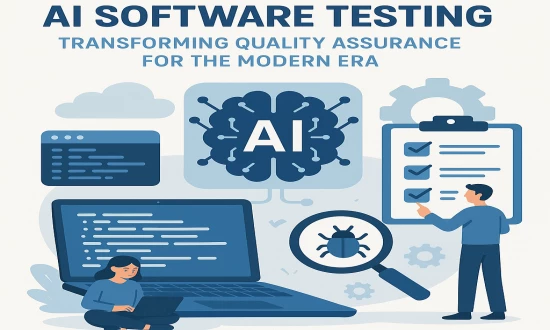1. What Is AI in Software Testing?
AI in software testing refers to the application of machine learning, natural language processing, computer vision, and automated reasoning to enhance or automate testing activities.
Instead of manually creating and maintaining hundreds of test cases, AI analyzes behavior, predicts risks, and generates tests automatically.
In short: AI makes testing faster, smarter, and more reliable.
2. Key Benefits of AI in Software Testing
- Faster Test Execution
AI-driven automation reduces the time needed to run regression tests, freeing testers to focus on complex scenarios.
- Improved Accuracy
Machine learning models detect anomalies that might be missed by human testers, reducing the risk of human error.
- Intelligent Test Case Generation
AI analyzes user behavior, system logs, and requirements to automatically generate the most relevant test cases and user flows.
- Lower Maintenance Effort
Traditional automated scripts break when the UI changes.
AI uses self-healing mechanisms to automatically update locators and fix tests.
- Predictive Analytics
AI predicts high-risk areas based on code changes, historical defects, and user patterns—enabling earlier defect detection.
- Better Test Coverage
AI can crawl applications to discover new pages and functionalities, ensuring better coverage with less effort.
3. How AI Is Used in Different Types of Testing
- Functional Testing
AI tools generate test scripts, validate UI changes, and perform regression testing more efficiently.
- UI & Visual Testing
Computer vision detects layout issues, visual bugs, and style inconsistencies that traditional tests often miss.
- API Testing
AI creates optimal API test sequences and analyzes responses for anomalies.
- Performance Testing
AI models simulate real user load patterns and predict performance bottlenecks based on trends.
- Security Testing
AI helps detect vulnerabilities by identifying suspicious patterns in code and traffic.
4. Real-World Use Cases
- Smart Test Generation
AI analyzes requirements or user stories and automatically creates test cases with expected results.
- Defect Prediction
Based on commits, code complexity, and past issues, AI highlights modules most likely to contain defects.
- Test Prioritization
In CI/CD pipelines, AI selects the most critical tests to run first, speeding up release cycles.
- Self-Healing Test Automation
If a button changes color, size, or position, AI updates the script without breaking the test.
5. Popular AI Testing Tools
Here are widely used tools that integrate AI into the testing workflow:
- Testim – AI-based test creation and self-healing automation
- Mabl – Intelligent end-to-end testing and visual validation
- Applitools Eyes – AI-powered visual testing
- Selenium + AI add-ons – Improving locator reliability
- Katalon with AI – Smart test creation and maintenance reduction
- Functionize – Machine-learning-based cloud testing
These tools help teams move from “automated scripts” to “intelligent testing systems.”
6. Will AI Replace Testers?
The short answer: No — AI will not replace testers.
Instead, it will replace:
- repetitive tasks
- fragile automation scripts
- manual regression testing
Human testers will shift toward:
- exploratory testing
- risk analysis
- user experience evaluation
- test strategy and decision-making
AI becomes a powerful assistant, not a replacement.
7. The Future of AI in Software Testing
As AI continues to mature, we’ll see:
- More autonomous testing pipelines
- Fully self-healing test suites
- Deeper integration with DevOps and CI/CD
- More accurate risk-based testing
- Faster release cycles with stronger quality guarantees
AI will enable QA teams to deliver higher-quality software with unprecedented speed and confidence.
Conclusion
AI is reshaping the future of software testing by making it faster, smarter, and more efficient. Organizations that adopt AI-driven testing gain a competitive edge: quicker releases, fewer bugs, and improved customer satisfaction.
While AI automates the heavy lifting, human testers remain essential for creativity, strategy, and understanding real user needs.
In today’s world, the strongest testing teams are those that combine AI technologies with human expertise.



